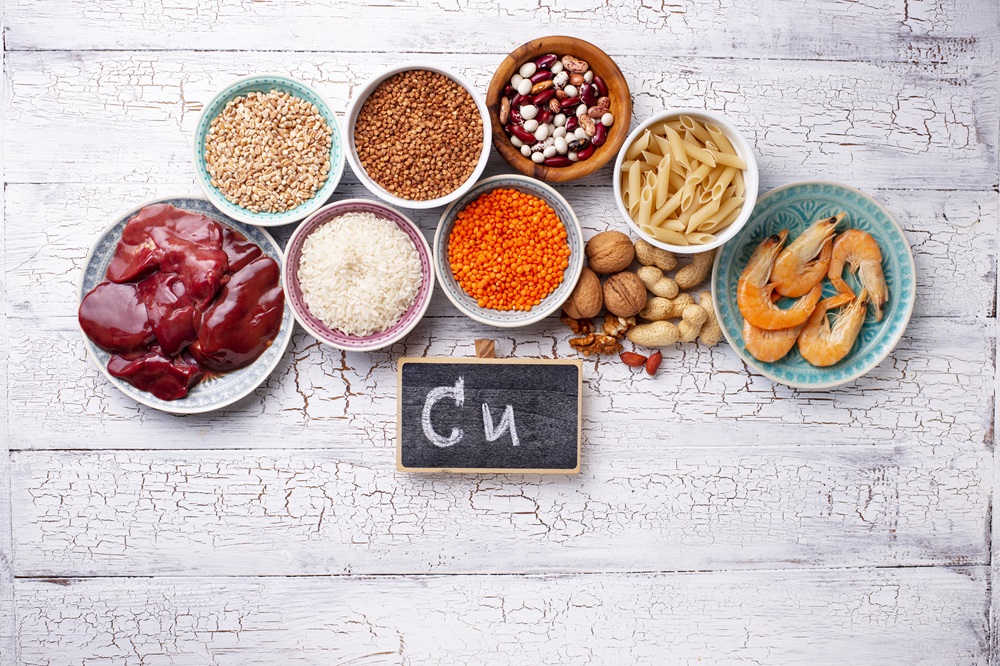Copper – Properties, Sources, Requirements

Copper is a trace element commonly found in food, offering numerous valuable properties. It can support the function of the nervous and immune systems, take part in many enzymatic reactions, and assist in the production of red blood cells. This nutrient is essential for the proper functioning of the human body - however, both excess and deficiency can disrupt normal physiological processes. What are the properties of copper? What are the best sources? What can cause copper deficiency or excess, and what are their symptoms?
Table of contents
Copper - what is it?
Copper, symbol Cu, is a trace mineral essential for the human body. Present in small amounts, it is mainly stored in muscles and bones, as well as in the liver, kidneys, heart, and brain. In nature, copper is found as ore or mineral.
Sources of copper - which foods contain it?
Copper occurs in both animal and plant-based foods. The richest sources include:
- organ meats, such as liver
- shellfish, including crayfish, crabs, and oysters
- nuts, such as hazelnuts and cashews
- seeds, such as sunflower and sesame seeds
- shiitake mushrooms
- potatoes
- dark chocolate
It can also be found in bran, whole grain products, legumes, salmon, avocado, and dried figs. Smaller amounts occur in spinach, asparagus, and tomatoes.
Properties of copper - what is its role in the body?
Copper performs many vital functions. It is involved in energy production, connective tissue synthesis, and iron metabolism, aiding its absorption in the intestines, releasing stored iron, and incorporating it into hemoglobin.
It supports the circulatory system by promoting the formation of new blood vessels, contributing to red blood cell production and hemoglobin synthesis. It may influence blood clotting and heart function.
Copper participates in many biochemical reactions as an essential component of enzymes, often forming catalysts by binding with amino acids. It is also necessary for proper brain function and plays a role in neurotransmitter production.
It may have antibacterial properties, inhibiting microbial growth, and support T-cell activity, boosting immunity. Copper also aids wound healing and, through its role in collagen synthesis, helps maintain healthy bones and bone matrix, potentially lowering osteoporosis risk.
Additionally, copper is involved in hair and skin pigmentation by participating in melanin metabolism, which can delay graying. As a component of copper-zinc superoxide dismutase, it helps protect the body from free radicals and reactive oxygen species, slowing aging processes.
There is also evidence that copper supports male fertility by influencing cell division and sperm production. Both deficiency and excess can negatively affect sperm quality and reproductive function.
Daily requirement for copper
According to the Polish Nutrition Standards set by the National Food and Nutrition Institute, the Recommended Dietary Allowance (RDA) for adolescents aged 13 and over and adults is 0.9 mg/day.
Children require:
- ages 1–3: 0.3 mg/day
- ages 4–6: 0.4 mg/day
- ages 7–12: 0.7 mg/day
Needs increase during pregnancy to 1.0 mg/day and during lactation to 1.3 mg/day.
Copper deficiency
Because copper is needed in very small amounts, deficiency is rare. It is most often seen in people with genetic disorders affecting copper metabolism or those consuming excessive zinc supplements. It may also affect low-birth-weight infants, premature babies, and individuals with malabsorption syndromes or cystic fibrosis.
Some data suggest that vitamin C and iron may reduce copper bioavailability.
Symptoms of copper deficiency include:
- anemia due to impaired iron transport and absorption
- neutropenia (low white blood cell count)
- weakened immune function
- brittle bones and increased fracture risk
- higher risk of osteoporosis
- abnormal bone development
- skin and hair depigmentation and premature graying
- cognitive issues, memory and concentration problems
Copper excess
Like deficiency, copper excess is rare but can be toxic. It is usually caused by improper use of dietary supplements rich in copper. High levels can also result from using copper cookware, which releases the metal into food and water. Occupational exposure can affect welders, copper and steel workers, and jewelry or dental material manufacturers.
Symptoms of excess copper include:
- digestive issues such as vomiting, abdominal pain, nausea, and diarrhea
- metallic taste in the mouth
- liver damage or dysfunction
- kidney damage or failure with prolonged exposure
Copper supplementation - is it worth it?
Although copper is widely available in everyday foods, supplements may be helpful for those with confirmed deficiency or increased needs.
Copper supplements come in tablets or capsules, either as single-ingredient products or combined with other minerals and vitamins such as selenium, manganese, vitamin E, or B vitamins. The best choice depends on individual needs.
It is worth checking the chemical form – copper gluconate, an organic form, is considered well-absorbed.
Since excessive copper can be toxic, supplementation should only follow proper testing to confirm the need.
Copper supplements - contraindications
Naturally occurring copper in food poses no risk to health, but supplements may be unsafe for some individuals. People with certain genetic conditions, particularly Wilson’s disease, should avoid them. This disorder impairs copper metabolism, causing dangerous accumulation in the brain, liver, and other tissues.

